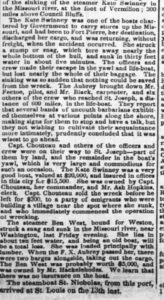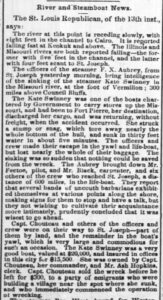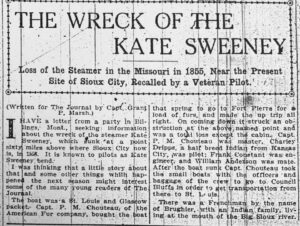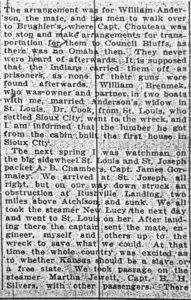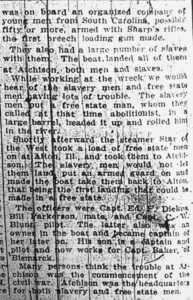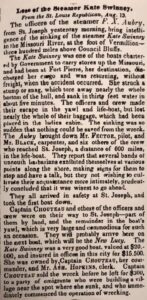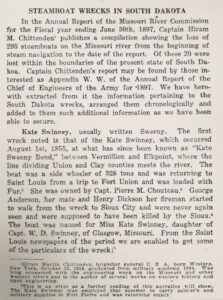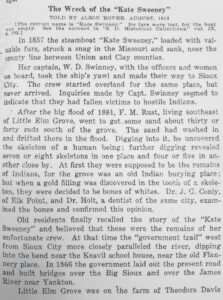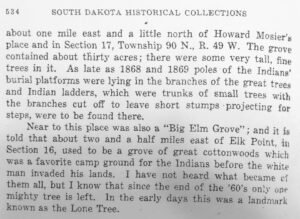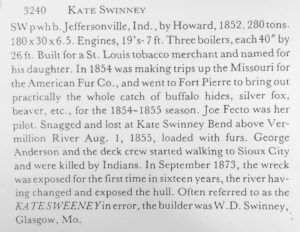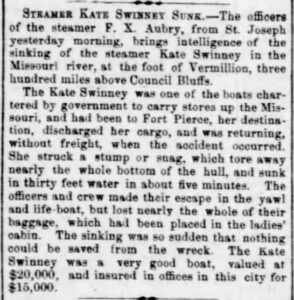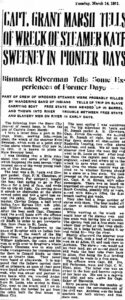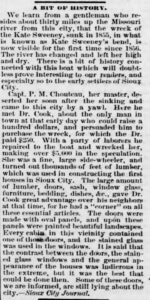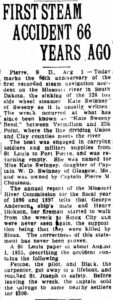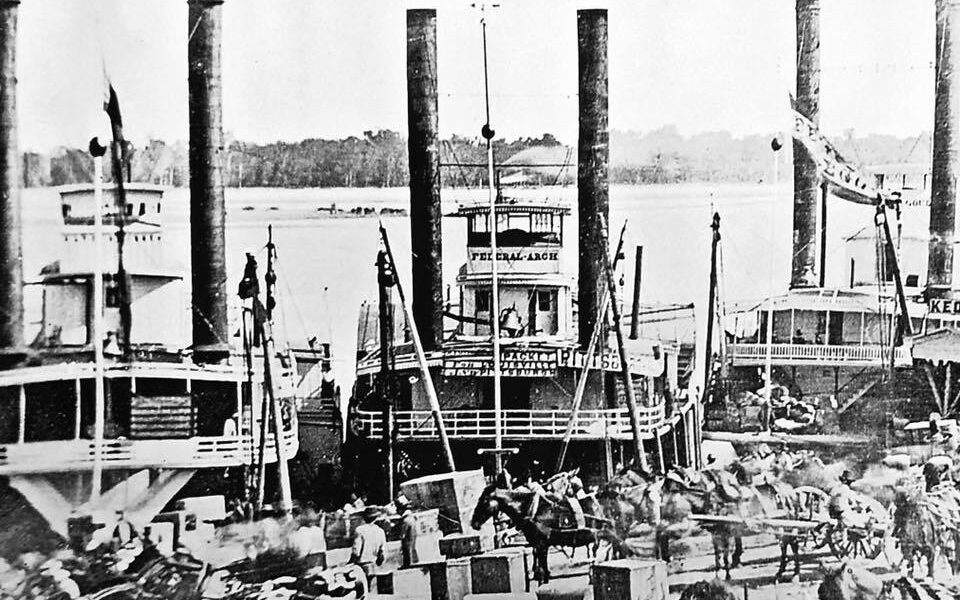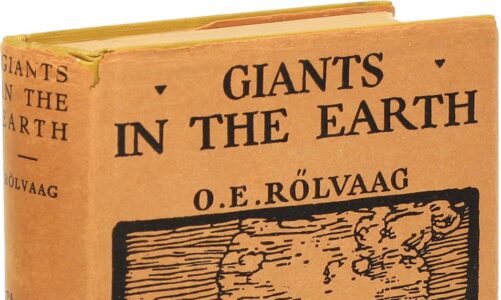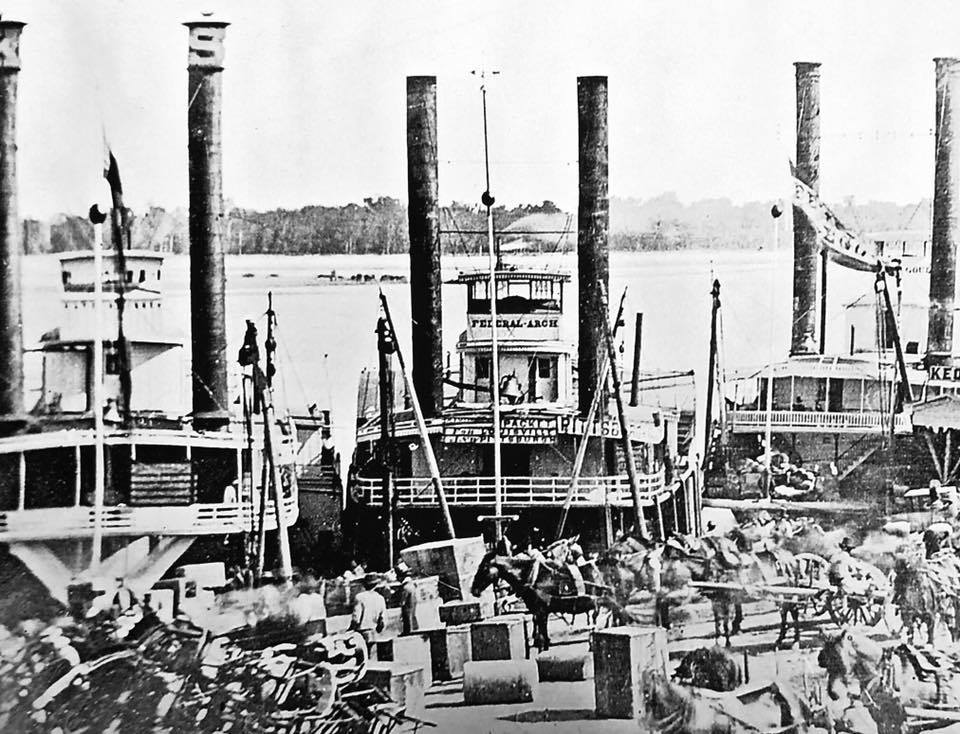
Thank you, Kim Callahan, for sharing the mystery below with us!!
On August 1, 1855, the side-wheeler steamboat named “Kate Sweeney” struck a snag and sank on the Missouri River below present-day Vermillion. Its exact location is unknown due to the continual change of the river’s channel over the years. Best estimates place in south-southeast of Burbank Lake on the Clay/Union County line.
The boat was a side-wheeler of 328 tons fully loaded with furs and returning to St. Louis after a trip upriver to Fort Union. The “Kate Sweeney” was owned by Captain Pierre M. Chouteau. The boat was named for Miss Kate Sweeney who was the daughter of Captain W. D. Sweeney of Glasgow, Missouri.
From the newspapers of that period from St. Louis, a few particulars of the wreck were obtained: Fectoe the pilot and the carpenter named Black got away in a lifeboat and reached St. Louis in safety. Before leaving the area, it was said that the Captain sold the salvage to some nearby settlers.
What was later learned of course, was a bit more ominous. George Anderson the “Kate Sweeney’s” mate, Henry Dickson her fireman along with several deck-hands set out by foot overland in an attempt to reach the early day settlement of Sioux City. There was a limited amount of room for people in the lifeboat (yawl).
Anderson, Dickson, and deck-hands never made it to Sioux City. Chouteau made inquiries in the area when these men did not meet up with them in St. Louis.
It was always speculated that the bulk of the “Kate Sweeney” crew was killed by Indians who frequented the area.
Over the years this incident faded into obscurity with the exception of some older residents in southern Union County. The only thing to remember them by was the naming of ‘Kate Sweeney Bend” near the Clay/Union line on the Missouri River. Most bends were named after steamboat wrecks.
The memory of the “Kate Sweeney” and its ill-fated crew became a faded memory, at least until 1881. This was the year of the big Missouri River flood that caused so much devastation to Yankton and Vermillion. Elk Point like other communities near the Missouri River was affected. A Mr. F. M. Rust living southeast of an area known locally as “Little Elm Grove,” went to get some sand about 30 or 40 rods south of the grove. The sand had washed in and drifted there as a result of the flood. Shortly after he began digging, Rust uncovered a human skeleton. Further digging on his part yielded eight more human skeletons. He found a group of four skeletons in location and another group of four close by. At first, these skeletons were thought to be the remains of Indians, for “Little Elm Grove” was a burying place for Indians. Early settlers could recall finding scaffolds in the trees with Indian remains. This thought pattern changed when it was found that a gold filling was discovered in the teeth of one of the skulls. From that point, Rust felt he was dealing with the bodies of white men rather than Indians.
It was at this point that Rust went into Elk Point for some help. He returned with Dr. J. G. Conly and Dr. Holt the local dentist along with some other Elk Point residents. While these skeletons were being examined some of the older townsmen believed that the missing crew of the “Kate Sweeney” had been discovered by Rust. As they recalled, the “government trail” west from Sioux City closely paralleled the Missouri River, until it dipped into a bend near the old Kevill School House, close to what was known as the old Flanery place. By 1866 the government had laid out the present road and built bridges over the James River near Yankton.
“Little Elm Grove” was located then on the farm of Theodore Davis about one mile east and a little north of Howard Mosier’s place and in Section 17, Township 90 N. R. 49 W. At that time the grove contained about 30 acres. There had been some very tall and fine trees in it. It was said that as late as 1868 and 1869 poles of the Indians burial platforms were still lying in the branches of the great trees. Indian ladders which were trunks of small trees that had the branches cut off were found to be there.
What this group did with the skeletons uncovered by Mr. Rust is perhaps a greater mystery. No mention of them or if they’re were buried at the same location was ever found to recorded again.
Perhaps to this day they lay in some unknown pasture with only a lingering story being their memorial.
